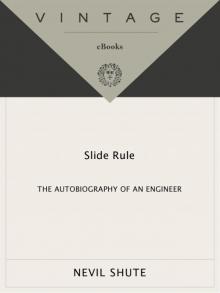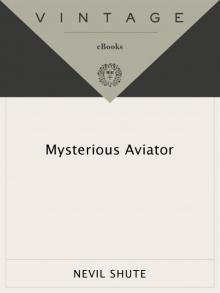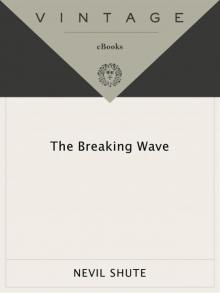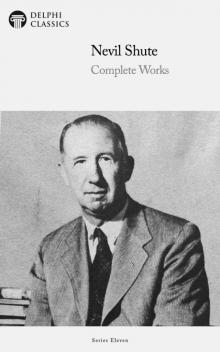- Home
- Nevil Shute
No Highway Page 5
No Highway Read online
Page 5
“There’s not a shred of evidence that you can hang your hat on that there’s anything wrong with them at all,” I said evenly. “But—yes, I think he’s probably right.”
“Why do you think that,” she asked quietly, “if there isn’t any evidence?”
“Fifteen years in the aircraft industry,” I said. “One gets to know the smell of things like this.”
I reached for the cigarettes and gave her one, and lit one myself. We sat in silence for a time; I lay back in my chair and watched the blue clouds rising slowly to the ceiling, deep in thought. And presently she asked, “What’s Mr. Honey going to do about it?”
I grinned at her. “He’s going to hire an electric hot-water-heater,” I said. “He’s already bought a mop.”
I went up to the Ministry in London first thing next morning and saw Ferguson; I told him the whole thing. He was inclined to regard it as a mare’s nest, having had some experience of Mr. Honey over the lunch-table while he had been at the R.A.E. himself. “I don’t want to say anything against a member of your staff, Scott,” he remarked. “But there may be things you wouldn’t know about, that you really ought to know. Poor old Honey had a lot of trouble at the end of the war, you know—he lost his wife. That changed him a lot—he’s never been the same man since. It was very distressing, that.”
He paused, and glanced at me. “Did he ever tell you about his experiments with planchette?”
I was not now surprised at anything to do with Mr. Honey. “You mean, spiritualistic stuff?” I asked. “I’ve heard a lot about him, but I hadn’t heard that one.”
He hesitated. “I dare say it’s all over now. It was probably an effect of the distress he suffered at the time. But he used to do a lot with that.”
I was suddenly deeply sorry for the uncouth little man. “Trying to get in touch with her, and all that sort of thing?”
He nodded.
I thought about it for a minute. “I hadn’t heard of that,” I said at last. “I knew that he was religious, in an eccentric sort of way. But I don’t think any of that really concerns us now. What I feel is this—that we can’t let this thing slide, even if we both think that Honey’s as mad as a hatter. He has made this forecast, for what it’s worth, and the prototype did crash about that time. We’ve got to get to the bottom of it, now.”
“Oh yes, of course we have,” he replied. “But in the meantime, I shan’t lose much sleep myself.”
He rang through to Group-Captain Fisher in the Accidents Branch, and we went down to see him. After the preliminary greeting, I said:
“Look, sir—I’ve come up because we want to know a bit more about that accident to the prototype Reindeer.”
He nodded. “You rang me up for the flying time. Just under 1,400 hours, if I remember right.”
“That’s right, sir. We’ve been studying fatigue down at Farnborough, and a suggestion has been made that the tailplane might have failed on that machine.” I started in and told him the whole thing again, of course omitting the gossip about Mr. Honey. I was getting to know my story off by heart by that time, from having told it to so many people.
As I talked, the frown deepened on his face. I came to the end, and he said, “Do I understand, then, that there is a suggestion that my staff have been completely in error in their analysis of this accident?”
I hesitated. I did not want to get on the wrong side of the Group-Captain at the start. “I wouldn’t put it quite like that,” I said. “We feel down at our place that this new evidence requires consideration alongside of all the evidence you have gathered up to date.”
He glowered at me. “I don’t know about new evidence,” he said. “If I understood you correctly, you have an estimate from a research worker of what he hopes will happen in a trial which is in progress now. Is that right?”
I said, “That’s about it. We have been very much impressed with the way his estimate coincides with the flying time to crash of this first Reindeer.”
“Well, I’m not,” he said. “There’s no magic in the figure 1,400.” He rang a bell upon his desk. “In this department, when we speak of evidence we mean evidence, sworn testimony that can be proved and that would stand up in a court of law. Not supposition and impressions.” A girl appeared, and stood in enquiry at the door. “Get me the report upon the Reindeer accident, Miss Donaldson,” he said.
We sat in silence while the girl fetched the report; he did not seem to be in a very genial mood and I did not want to put my foot in it again, so I was saying as little as possible. She brought in a bulky folder bound up in the manner of a final report and handed it to him, and went away. He turned over the pages of it on his desk in silence for a time.
He said at last, “Well, this is the report. The actual investigation was carried out by Ottawa, of course, with our representative assisting. I suggest you take it away and read it, as a first step. Then if you want any more information, we can have another talk.”
“That’s very kind of you, sir,” I said. “I’ll read this through at once and get in touch with you again.”
I went back with Ferguson to his office. When we got there, “What’s eating the old boy?” I asked. “I’ve always found him very helpful in the past.”
Ferguson said, “Well, of course—this is a final report.” He took it in his hands thoughtfully, considering it. “It’s gone to the Minister, and there was a question in the House of Commons—the Minister based his reply on this. Because of the Russians, you know.” I nodded. “Naturally, Fisher won’t exactly jump for joy if you turn up and prove that it’s all wrong.”
I said irritably, “But damn it, man—we all make mistakes. I make them, so do you, and so does every living being in the world. One just has to admit them—Fisher’s not a child. If this report is based on a misapprehension it’ll have to be corrected—we can’t hide things up. There’s no future in that.”
“I know,” he said thoughtfully. “The trouble is that Fisher’s department has been making rather a lot of mistakes recently.” He paused. “You heard about the Zulu crash at Whitney Sutton?”
“I heard the wings came off, or something. I didn’t hear why.”
“That’s right,” he said. “It was diving at round about Mach unity, and the wings came off. The ailerons came off first and then the wing broke up. Fisher’s party got it all buttoned up as pilot’s error of judgment. But then Cochrane from the Medical Research came in and proved pre-impact head wounds on the pilot’s body. The windscreen broke up and crashed into the pilot’s face—that’s why it dived. It didn’t do Fisher any good with the R.A.F. types.”
I was interested. “Is that established? Is that what really happened to it?”
He nodded. “Keep it under your hat, old boy. No point in spreading things like that about.”
I settled down in Ferguson’s armchair to read the report upon the accident to the prototype Reindeer.
It had flown from London Airport on the night of March 27th with a crew of nine and a passenger list of twenty-two persons, including the Russian Ambassador to Ottawa, thirty-one people in all. It had been diverted from Gander on account of fog and had landed at Goose at about 7 a.m. G.M.T. on the morning of the 28th. It had refuelled there, and had taken off for Montreal at 9.17 in weather that was overcast and raining; the temperature was above freezing, unusual for the time of year. The crew had not reported any trouble at Goose. One wireless message of a routine character was received at 9.46 reporting that the aircraft was on course at 16,500 feet. That was the last that was heard of it.
It was three days before it was reported by one of the search aircraft, though the spot where it was finally located had been flown over several times. It was another two days before a party succeeded in getting to the wreckage. They flew up in a Norseman fitted with skis and landed in deep snow on a frozen lake called Small Pine Water; the landing was a hazardous one because of the alternate thaw and freeze: the skis mushed in beneath the icy crust. The party then had to f
orce their way eleven miles over the snow-covered hills, thickly covered with a, forest of spruce and alder. The night temperatures were as low as –45° Fahrenheit, making it a most difficult search: several of the party suffered from frostbite. In the deep snow and the forest growth they would never have found the crash at all but for the continuous guidance given by the aircraft working with them.
In the circumstances, it is hardly surprising that their investigation was, in some respects, perfunctory.
The spot where the Reindeer crashed was about 250 miles from Goose, about 50 miles west of the Moisie river and about 100 miles north of the sea coast in the Gulf of St. Lawrence. It was just in Canada, in the Province of Quebec.
The bulk of the aircraft was found lying in deep snow among trees at the foot of a cliff, the estimated height of which was 340 feet. It had been on fire after the crash, and everything in it was totally destroyed. All the bodies were found within the flattened shell of the fuselage, indicating that nobody had survived the accident. The cliff face at that point ran approximately east and west along the aircraft’s course, and the Reindeer had hit first at the top of this cliff, very near the edge. It had knocked down three trees, and here the starboard wing had been torn off; the wing was found at some distance from the rest of the machine, at the foot of the cliff. Two propeller blades and portions of the engine cowling were found on top of the cliff. The fuselage had then toppled over the cliff and had crashed down into the forest below, and burnt out.
From the damage to the trees it seemed that the original impact, the first touch, had been with the machine at a small angle of descent, probably not more than ten degrees below the horizontal. From that the investigators had deduced that the machine was under control up to the moment of impact, and from that that the pilot had been deliberately losing height through the overcast in order to check his position by a sight of the ground.
Ferguson, reading all this over my shoulder, said doubtfully, “Well, that could be. But it sounds a bit odd to me. He was only an hour out from Goose. What should he want to check his position for?”
I shrugged my shoulders and turned to the photographs bound up with the report. The photographers were technicians, not sensation-mongers, and they had not gone out of their way to photograph the horrors; but it was not a pretty scene. The wreckage, of course, was hardly recognisable as an aircraft at all; in modern accidents it never is. It looked like the scrap head of a tin factory. I turned the pages one by one, examining each photograph in turn minutely.
“I don’t see the port tailplane anywhere,” I said at last.
“If it’s missing, it’ll be referred to somewhere in the text,” said Ferguson. “Let me have a look.”
He turned the pages till we found what we were looking for. The passage read:
The party remained on the site of the accident for three days, during which time the 31 bodies were buried in individual graves. The whole of the units of the aircraft were not accounted for, due to the dense nature of the forest at this point. It was impossible to see further than three yards in any one direction because of the thickness of the undergrowth laden with snow, and no progress was possible except along paths cut for that purpose. The daytime thaw made all work wet and difficult and greatly hampered the search. The units of the aircraft unaccounted for were the starboard aileron, the outer starboard engine No. 6, the port tailplane and elevator, the port landing wheel assembly, No. 3 propeller (parted from the engine by a fracture of the crankshaft), and about five feet of the tip of the starboard wing.
I glanced at Ferguson. “Port tailplane and elevator,” I said. “There we are.”
He nodded. “It’s not evidence, of course,” he said. “It keeps the fatigue theory in the field, in that if the tailplane had been there and intact it couldn’t have come off in the air. But the mere fact that the port tailplane was missing, when so much else was missing, doesn’t take us very far.”
“It’s beginning to tot up,” I said. “It’s one more thing.”
I settled down to read the report through carefully; when I got to the end I turned back to the beginning and read it through again, making notes as I did so. It was clear from the circumstances of the accident that the wreckage could not possibly have been removed. It would still be lying where it fell three months before, with the new growth of the forest coming up around it and through it, gradually obliterating everything. There was my evidence, all right, there in the woods. In one of the photographs I could see the broken stump of the front spar of the port tailplane. It would not be necessary, perhaps, to search the woods for the tailplane itself. If that broken spar attached to the rear fuselage showed the typical form of fatigue crystallisation of the metal at the fracture, there would be all the evidence we needed. It would, of course, be better and would make the matter more complete if we could get the tailplane, too.
In the middle of the afternoon I went down to see the Group-Captain again, ready to be firm.
“I’ve read through this report,” I said. “It’s very interesting, sir—and, if I may say so, the most comprehensive report I’ve yet seen on an accident. It’s very thorough.”
He smiled. “Got all you want from it?”
“I think so,” I said. “I should like to take it down to Farnborough to talk it over with the Director, if you could spare this copy for a few days?”
“That’s all right,” he said.
I went on. “Well, sir—about this suggestion that’s been made about tailplane fatigue. You’ll hear from us officially in the next day or two, if we want anything done. My present feeling—what I shall advise the Director—is that we should send an officer out there at once to make an examination of this broken tailplane spar.” His face darkened; I opened the report and showed him the photograph. “This one. As the port tail was missing altogether we can’t rule out this theory that has arisen. Of course, if it should be proved that fatigue is present in these aircraft at such an early stage, it’s a matter of the greatest urgency to put it right.”
I stared down at the photograph before us; it was horrible. “We don’t want another one like this,” I said.
Fisher said stiffly, “If you really think that necessary after the very careful investigation that has been already made, I suppose Ottawa can arrange it. If it comes at our request, of course, financial sanction will be necessary; these expeditions to out-of-the-way places like this are very costly, you know. It’s in a dollar area, too, so the Secretariat will have to submit the matter to the Treasury. But if you people insist upon it, I suppose it can all be arranged.”
“I can only state my own view, sir,” I said. “I think it’s necessary and a matter of great urgency. That’s what I shall tell the Director; I can’t say, of course, what he’ll decide. But I should like to see an officer on his way to Ottawa tomorrow, or the day after, at the latest.”
“It all seems rather ridiculous,” he grumbled. “The matter was most carefully gone into.”
I did not want to argue it with him, and I had given him warning of what was coming, as was only fair. I said good-bye and left the office with Ferguson. He was rather amused; in the corridor outside the office he turned to me, and grinned. “He’s putting up a good fight,” he said. “He knows all the tricks. He’ll run round to the Secretariat tonight and tell them that your journey isn’t really necessary.”
“He wouldn’t do a thing like that,” I said. I was a little worried at the mere suggestion. “He’s a good old stick—I’ve known him for years. And this thing concerns the lives of people in the air. He wouldn’t want to see another stinking crash like this.”
“Of course he wouldn’t,” Ferguson replied. “But you see—he thinks you’re absolutely wrong and just kicking up a stink in his department irresponsibly. People believe what they want to believe.”
I got back to Farnborough too late to see the Director. I went home with the report under my arm, tired and depressed by what had been my reading for the day. I was due to
read my paper on the “Performance Analysis of Aircraft flying at High Mach Numbers” on the following Thursday, the first paper that I had been asked to read before a learned society. When I got home I found that the advance printed copy of this thing had arrived, and that Shirley had been reading it all afternoon. She had taken it upstairs to show to Mrs. Peters in the flat above; it was a great thing for us, because it was the first distinction we had managed to collect since we were married. Fingering it and turning over the pages, and discussing with Shirley the cuts that I would make when reading it, served as an anodyne; it took my mind off the Reindeer misery, so that I slept fairly well.
I went down to see the Director first thing next morning. I showed him the Reindeer accident report, and told him all about my interviews with Group-Captain Fisher. “In spite of what he says, I think we ought to send somebody out there,” I remarked. “I should like to see an officer from here sent out by air straight away, sir, to make a metallurgical report on that spar fracture.”
“I think you’re right, Scott,” he said slowly. “I believe that’s the only thing to do. Who would you send?”
“I should send Honey.”
“You have sufficient confidence in Honey, Scott?”
I said, “I have, sir. I’m beginning to get quite a respect for Mr. Honey. I’m beginning to think he’s right in this thing, and he’s certainly the man in the Establishment who knows most about fatigue.”
“Yes, he is that.” He turned over the pages of the report, thoughtfully. “This place where the accident is located—I understand it’s eleven miles from a lake where you can land a seaplane? That’s a journey of eleven miles through the Canadian woods?”
“I think so.”
“I’m not so sure that Honey is the right man for that sort of assignment, Scott. He isn’t what I should describe as an outdoor type.” He paused. “You wouldn’t rather go yourself?”

 On the Beach
On the Beach Slide Rule
Slide Rule A Town Like Alice
A Town Like Alice The Far Country
The Far Country Pied Piper
Pied Piper Round the Bend
Round the Bend An Old Captivity
An Old Captivity Mysterious Aviator
Mysterious Aviator The Breaking Wave
The Breaking Wave Marazan
Marazan Lonely Road
Lonely Road Pastoral
Pastoral No Highway
No Highway Stephen Morris and Pilotage
Stephen Morris and Pilotage Complete Works of Nevil Shute
Complete Works of Nevil Shute Most Secret
Most Secret Beyond the Black Stump
Beyond the Black Stump The Rainbow and the Rose
The Rainbow and the Rose The Chequer Board
The Chequer Board Trustee From the Toolroom
Trustee From the Toolroom Ordeal
Ordeal Stephen Morris
Stephen Morris